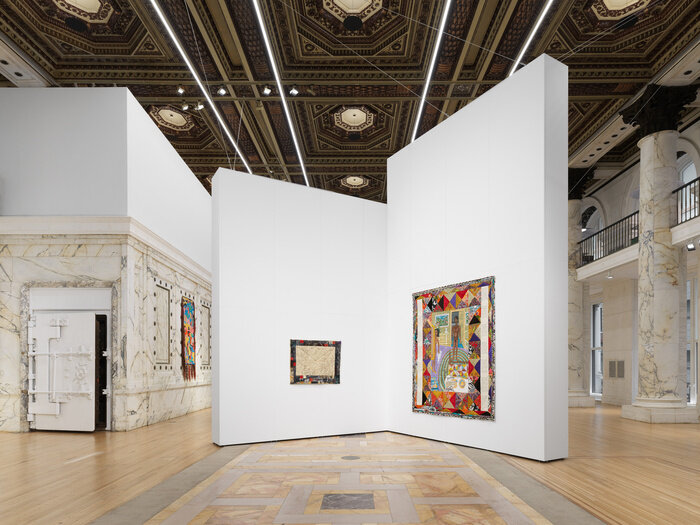Faith Ringgold
Works (Tap to zoom)
Biography
Faith Ringgold (1930-2024) is recognized as one of the most significant cultural figures of the twentieth and twenty-first centuries, whose impact and influence can be seen throughout the worlds of art and activism today. Over more than six decades, Ringgold distinguished herself as an artist, author, educator and organizer, as she understood the necessity of addressing the politics of race and gender in America in more ways than one. Restlessly creative and formally ambitious, Ringgold worked in a variety of media—from quilts and paintings to performances and children’s books—to create an incisive narrative about the historical sacrifices and achievements of Black Americans.
Ringgold’s extraordinary body of work originated from her political consciousness and activism during the 1960s and 1970s in Harlem, New York. By fusing together her own unique style of figurative painting—drawing from post-Cubist Picasso, Pop Art and traditional African sculpture and design—with a bold and innovative approach to composition, Ringgold created graphically complex works that highlighted the racial and gender inequalities within American society, first expressed through her series American People. She found applications for her unique formal sensibility within the context of political messaging as well, where she produced posters in support of the Black Panther Party and the freeing of activists such as Angela Davis. As an organizer in the 1970s, Ringgold was instrumental to the protests highlighting the lack of opportunities for women of color in the art world. Subsequently, in 1971, she established Where We At, Black Women Artists, Inc (WWA), a collective of black female artists who felt neglected not only by the mainstream, but also by the male dominated Black Arts Movement and the largely white Feminist one. Ringgold carried this advocacy further with the founding of the Anyone Can Fly Foundation in 1999, an organization which champions artists of the African Diaspora to audiences of all ages.
Ringgold’s desire to overcome the predominantly white art historical tradition led her to search for forms more suitable for the exploration of gender and racial identity, forms she found during her travels abroad in the 1970s, first to Europe and then to Africa. The soft sculptures, masks and unstretched canvases adorned with sewn fabric borders—inspired by Tibetan thangkas, which Ringgold called ‘tankas’—were the result of these exploratory trips and each would influence the creation of her quilt paintings and story quilts of the 1980s and 1990s. Her first quilt painting, Echoes of Harlem (1980), was made in collaboration with her mother, Madame Willi Posey, a prominent fashion designer in Harlem. From there, Ringgold went on to make her first story quilt, Who’s Afraid of Aunt Jemima? (1983), which, through its combination of European painting convention and the written word with the rich tradition of African-American quilt-making, would serve as a template for those to come. Regularly referencing her autobiography within episodes from the collective history of Black life in America, the story quilts are disarmingly intimate yet historically grand. They demonstrate the fundamental relation between the personal and the political that Ringgold’s art always understood.
In addition to her art and activism, Ringgold was also a dedicated teacher, first in the New York City public schools system throughout the 1970s and 1980s before moving to the University of California, San Diego, in 1987, where she remained until retiring in 2002. Ringgold was also a successful author of children’s books, often citing the formative influence of her years teaching young students. Her first children’s book, the award-winning Tar Beach, was published in 1991 by Crown. Based on the story quilt of the same name from the 1988 Woman on a Bridge series, the book has gone on to win more than 20 awards, including the Caldecott Honor and the Coretta Scott King Award for the best-illustrated children’s book of the year.
In 2022 Ringgold was the subject of a major retrospective, Faith Ringgold: American People, which opened at the New Museum, New York, before then travelling to the de Young Museum, San Francisco and the Museum of Contemporary Art, Chicago. In 2019 Serpentine Galleries, London opened Faith Ringgold, which then travelled to both the Bildmuseet Umeå, Sweden and Glenstone Museum, Potomac. From 2010 to 2013 American People, Black Light: Faith Ringgold’s Paintings of the 1960s opened at the Neuberger Museum of Art, New York and travelled to the Perez Art Museum, Miami, Spelman College Museum of Fine Art, Atlanta, and the National Museum of Women in the Arts, Washington, D.C.
Ringgold is included in numerous public collections, including the Brooklyn Museum, New York; Crystal Bridges Museum of American Art, Bentonville, AR; High Museum of Art, Atlanta; The Metropolitan Museum of Art, New York; Museum of Modern Art, New York; National Gallery, Washington, DC; National Museum of Women in the Arts, Washington, DC; National Museum of African American History and Culture, Washington, DC; Neuberger Museum of Art, New York; Philadelphia Museum of Art; Public Art for Public Schools, New York; Schomburg Center for Research in Black Culture, New York; Smithsonian American Art Museum, Washington, DC; Solomon R. Guggenheim Museum, New York; St. Louis Art Museum, Missouri; Studio Museum, Harlem, New York and The High Museum, Atlanta.
Exhibitions
